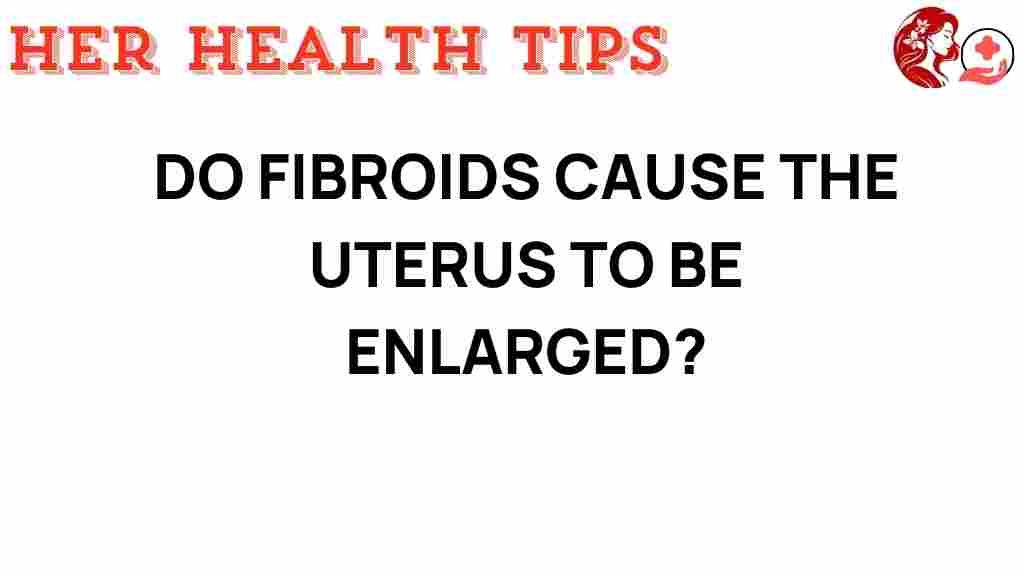Do Fibroids Cause Uterine Enlargement? Unveiling the Truth Behind This Common Concern
Uterine fibroids are non-cancerous growths that can develop within the uterus. They are quite common, affecting a significant percentage of women during their reproductive years. A common question that arises among women experiencing symptoms related to fibroids is whether these growths cause uterine enlargement. In this article, we will explore the relationship between fibroids and uterine enlargement, shedding light on symptoms, diagnosis, treatment options, persistent myths, and current medical research.
Understanding Fibroids and Uterine Enlargement
Fibroids, also known as leiomyomas, can vary in size, number, and location within the uterus. They are classified into three main types:
- Intramural fibroids: These grow within the muscular wall of the uterus.
- Subserosal fibroids: These protrude from the outer surface of the uterus.
- Submucosal fibroids: These develop just beneath the inner lining of the uterus.
Uterine enlargement, or uterine hypertrophy, refers to an increase in the size of the uterus. This condition can be attributed to various factors, including hormonal changes, pregnancy, and the presence of fibroids. Understanding whether fibroids contribute to uterine enlargement is essential for women’s health.
Symptoms of Fibroids
Many women with fibroids might not experience noticeable symptoms. However, when symptoms do occur, they can significantly impact quality of life. Common symptoms associated with fibroids include:
- Heavy menstrual bleeding
- Pelvic pain or pressure
- Frequent urination
- Backache or leg pain
- Difficulty emptying the bladder
- Constipation
- Enlarged abdomen or uterus
If you are experiencing any of these symptoms, it is crucial to consult with a healthcare provider for proper evaluation and diagnosis.
Diagnosis of Fibroids
Diagnosing fibroids typically involves several steps. A healthcare provider may conduct the following:
- Medical history and symptom review: Discussing symptoms and any family history of fibroids.
- Physical examination: A pelvic exam can help identify an enlarged uterus.
- Imaging tests: Ultrasound is the most common method for diagnosing fibroids, but MRI and CT scans may also be used.
These diagnostic tools help determine the size, location, and number of fibroids present, which is essential for planning treatment.
Do Fibroids Cause Uterine Enlargement?
Yes, fibroids can cause uterine enlargement. When fibroids grow, they can increase the overall size of the uterus, leading to what is perceived as an enlarged abdomen. This enlargement can occur due to:
- The size of the fibroids themselves, which can range from very small to larger than a grapefruit.
- The number of fibroids present; multiple fibroids can significantly increase uterine size.
- The type of fibroids; for instance, submucosal fibroids can cause more noticeable enlargement as they grow within the uterine cavity.
Women experiencing uterine enlargement should not automatically assume they have fibroids, as other factors can contribute to this condition. A comprehensive medical evaluation is necessary for an accurate diagnosis.
Treatment Options for Fibroids
When it comes to treating fibroids and associated uterine enlargement, several options are available, depending on the severity of symptoms and the size of the fibroids. Treatment options include:
- Watchful waiting: If fibroids are asymptomatic, doctors may recommend monitoring over immediate treatment.
- Medication: Hormonal therapies, such as birth control pills or GnRH agonists, can help manage symptoms.
- Minimally invasive procedures: Options like uterine artery embolization (UAE) can reduce blood flow to fibroids, causing them to shrink.
- Surgical options: In cases where fibroids cause severe symptoms, a myomectomy (removal of fibroids) or a hysterectomy (removal of the uterus) might be considered.
Each treatment option has its benefits and risks, and the choice depends on individual circumstances, including the woman’s age, desire for future pregnancies, and overall health.
Myths About Fibroids and Uterine Enlargement
There are several myths surrounding fibroids that can lead to confusion and misinformation. Here are a few common myths:
- Myth 1: All fibroids cause symptoms.
In reality, many women with fibroids experience no symptoms at all. - Myth 2: Fibroids lead to infertility.
While fibroids can affect fertility in some cases, many women with fibroids can conceive. - Myth 3: Surgery is the only treatment for fibroids.
There are several non-surgical treatment options available.
Understanding these myths is crucial for women’s health, as it encourages informed decision-making regarding treatment and management.
Current Medical Research on Fibroids
Ongoing research continues to shed light on fibroids, their causes, and effective treatments. Here are some key areas of focus in medical research:
- Genetic factors: Studies are investigating genetic mutations that may predispose women to develop fibroids.
- Hormonal influences: Research is exploring how hormones influence the growth of fibroids, particularly estrogen and progesterone.
- New treatment methods: Clinical trials are assessing the effectiveness of new medications and technologies for treating fibroids.
For more in-depth information on current research, you can visit NCBI for access to numerous studies and articles.
Troubleshooting Tips for Managing Fibroids
If you suspect you have fibroids or are experiencing symptoms, here are some troubleshooting tips:
- Keep a symptom diary: Track your symptoms, menstrual cycle, and any changes you notice.
- Consult a healthcare provider: Discuss your concerns and undergo necessary tests for diagnosis.
- Educate yourself: Understanding fibroids and treatment options can empower you to make informed choices.
- Seek support: Consider joining support groups for women dealing with fibroids for shared experiences and advice.
Conclusion
In summary, fibroids can indeed cause uterine enlargement, leading to various symptoms that can impact women’s health. Understanding the relationship between fibroids and uterine size is crucial for accurate diagnosis and effective treatment. By separating fact from fiction and staying informed about current research, women can navigate their health concerns more confidently.
If you suspect you have fibroids or are experiencing symptoms of uterine enlargement, it is essential to consult a healthcare professional for evaluation and tailored treatment options. Remember, you are not alone, and help is available.
For more information on women’s health and related topics, feel free to explore our other articles here.
This article is in the category Reproductive and created by HerHealthTips Team
